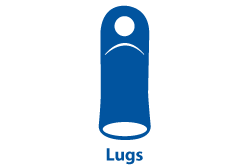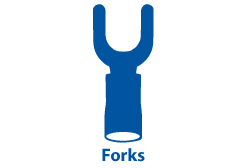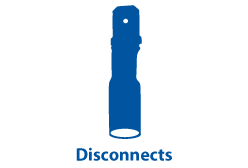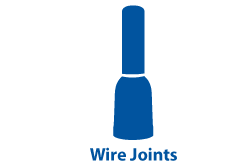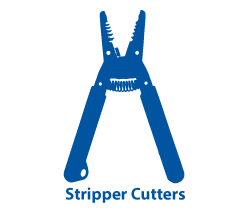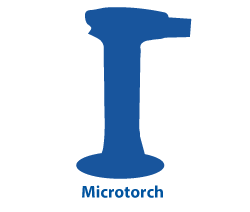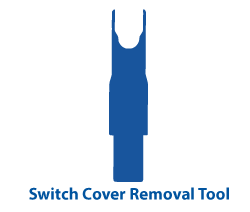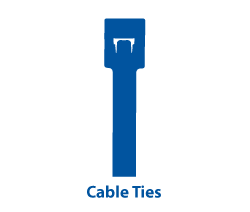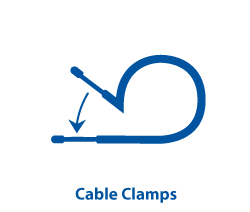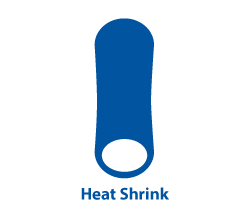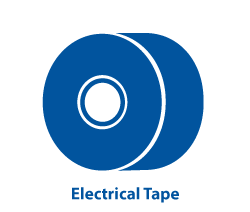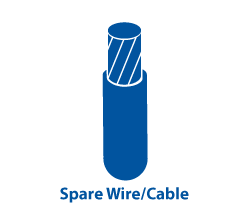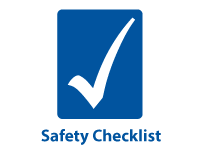Marine Toolbox Essentials
Posted by Pacer on 30th Apr 2024
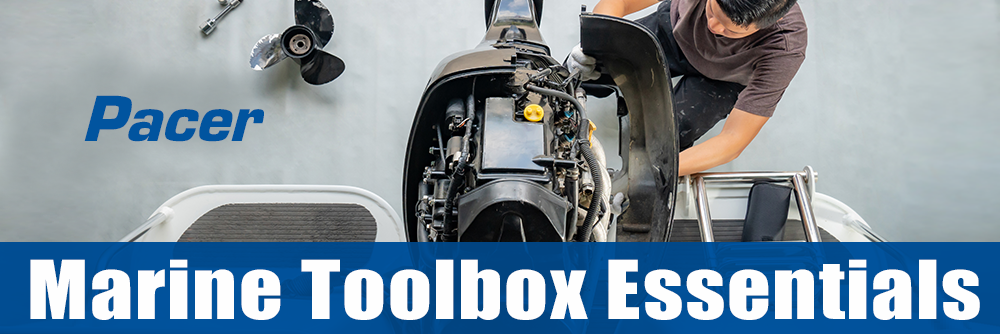
Having a toolbox on your boat is a must. From performing maintenance to handling on-the-spot issues, having the essentials in your toolbox can mean the difference between a great day on the water or not. Whether you’re just now getting a boat for the first time, or you’ve had one for years, it is important to prepare your boat’s toolbox to handle any unforeseen issues. We can all agree, preparation is key. Many people fail to realize just how different the marine environment is from their car or workshop and because of this they fail to include some of the most important tools in their toolbox. In this article, we will cover some of the lesser-known items you will definitely want to keep on your boat. Let’s dive right in a start with some of the terminals and connectors you will want to have on hand.
"It is important to prepare your boat’s toolbox to handle any unforeseen issues. We can all agree, preparation is key."
Terminals and Connectors
When it comes to terminals and electrical connector types, there are hundreds of options to choose from. Rather than consider all those options, let us look at some of the most common wire connectors you’re likely to encounter, what they can do, and where you are likely to use them.
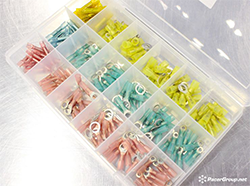
Terminal kits are premade boxes that contain various ring terminals and butt splices. What makes terminal kits so useful is the fact that the kit contains the most common sizes. You get #8, #10, 1/4”, 5/16”, and 3/8” ring terminals all separated by stud size and gauge size. Available in either nylon insulation or heat shrink insulation, terminal kits are perfect for handling the marine environment. The durable plastic terminal kit container is small enough that it easily tucks away on any boat. This means that it can remain out of sight but be readily available when you need it most. Before we move on, here are some quick tutorials on How to install ring terminals and How to use heat shrink butt splices. Now that we have covered terminal kits, let us briefly look at some of the other types of terminals and electrical connectors you will want to keep on your boat.
Lugs – These types of crimp connectors are commonly used to connect a battery cable to a battery. They are essentially extra-large ring terminals built for conductivity and longevity. These can help if you are having battery connection issues.
Forks – More often than not, fork terminals are used to connect a wire to a bus bar or similar piece of equipment. These electrical wire connectors are useful as they do not require you to fully remove a screw or nut to properly attach them. For a detailed explanation of how to use fork terminals, click here.
Disconnects – These crimp connectors made so that a connection can be disconnected and reconnected multiple times. Disconnects are a great tool when you know a piece of equipment will need to be maintained or possibly even moved.
Wire Joints – Sometimes you may need to connect two or more wires together or possibly even make a dead end. In these cases, wire joints are the perfect solution. They install quickly and offer long term protection in the harshest marine conditions.
Tools
Now that we have covered terminals and connectors, we can shift gears and look at some of the tools you may need. Tools are an essential part of every boat. Just imagine being stuck on your boat on the water with the equipment you need, but no tools. We know you already have your screwdrivers, pliers, hammer, and the like, so we are going to discuss the tools you may not think to keep onboard. This list is by no means comprehensive and should be considered additions to what you already have in your toolbox.
"We know you already have your screwdrivers, pliers, hammer, and the like, so we are going to discuss the tools you may not think to keep onboard."
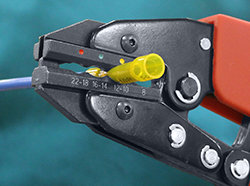
This tool is so potent we
use it on our own
production lines.
Ratcheting Crimper VTTR50 – This is a tool we recommend often, and for good reason. Our ratcheting crimper is built to handle insulated terminals ranging from 22 gauge all the way to 10 gauge. To be clear, that covers the vast majority of the terminals you’ll likely be dealing with on your boat. It is designed to easily tackle heat shrink, nylon, and even vinyl insulated terminals with ease. It has four color crimp nests to eliminate the risk of errors. They are 22-18 AWG, 16-14 AWG, 12-10 AWG, and 8 AWG crimp nests. This tool has also been designed for repeatability and reliability in even the toughest of marine conditions. It is built to give the exact crimp pressure each and every time. This tool is so potent we use it on our own production lines.
Strippers/Cutters VT45-121/VT45-124 – Most people who work with electricity have a pair of wire strippers however if you don’t, these are the best option. In order to make on-the-spot repairs, you are going to need to be able to properly cut and strip the wires you’ll be working with. These tools are designed to do just that. The VT45-121 handles 26-16 gauge stranded wires whereas the VT45-124 handles 10-8 gauge (solid) and 20-12 gauge (stranded) wires. These tools both have plier nose tips making them even more useful in a pinch.
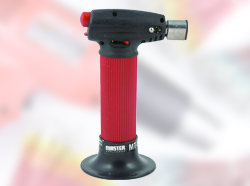
Microtorch – Having a heat tool on a marine vessel seems a little counterintuitive at first but it is actually a very useful tool in a pinch. A heat tool is literally one of the most versatile tools out there as it can handle a huge range of tasks. They can be used to perform tasks such as soldering, pinpoint heating, removing surface components, repairing vinyl, shrinking heat shrink, spot drying, activating adhesives, bending plastics, defrosting, forming plastics, drying, curing, gluing, softening materials, and even stripping paint. On a marine vessel, you will likely be using it to activate epoxy-lined heat shrink in order to create environmentally sealed connections, but it can do so much more. Having a heat tool safely stored in your toolbox is a smart move.
Switch cover removal tool – Trying to remove switch covers without the proper tool can lead to damage to the switch cover, or even worse, the switch body itself. By having and using the switch cover removal tool you eliminate the risk of damage. This lightweight tool is extremely durable and easy to use. Check out this video to see just how simple this tool is to operate.
Wire Management Materials
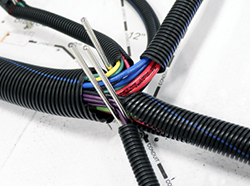
Believe it or not but wire management is sometimes overlooked by even veteran boaters. This is a serious mistake to make. Without wire management, you leave your electrical system much more vulnerable to the hazards of the marine environment. They offer protection from abrasion, impact, and even cutting. Overall, they protect your wire runs, simplify the process of navigating the electrical system, and even segregate wires by function or intended location. Seriously, the importance of wire management materials cannot be overstated. Especially, when you consider all that they offer. Let’s look at some of the most important wire management materials to keep in your toolbox.
"Overall, they protect wire runs, simplify navigating the electrical system, and even segregate wires by function or intended location."
Cable ties – Everyone knows just how useful cable ties are. From bundling wires and cables to securing objects, they’re a versatile tool to keep in your toolbox. It is a good idea to keep cable ties of varying lengths and tensile strengths to be able to handle the widest range of jobs. Remember, natural cable ties are for indoor use whereas black cable ties, which are UV resistant, are good for both indoor and outdoor use. Common cable ties become brittle and may break over time which is why we only carry high-quality cable ties designed for longevity. They are so long lasting in fact that some of our previous customers have included NASA.
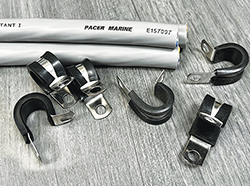
Cable clamps – Having a handful of cable clamps in your toolbox is a smart move. They quickly and easily cover wire runs. Cable clamps can be used to secure those wire runs as well as cables to just about any solid sturdy surface such as the underside of a table or a wall. The constant vibration and flux of the marine environment are mitigated by properly using cable clamps. All it takes is a single screw and a few seconds and your wires will be securely bound in place. Cable clamps are known for their ease of installation, durability, high strength, and versatility. We highly recommend keeping a few of these on hand. Trust us when we tell you, cable clamps are extremely useful, especially when you in are in a pinch.
Heat shrink – Epoxy lined heat shrink offers a level of protection you will not get with other products. Properly used heat shrink can create an environmental seal that can protect internal conductors from exposure. Most boaters do not keep heat shrink in their toolbox as it is commonly used for new installations and repairs. The important thing to remember is that you do not know when you will need to make repairs. This is why it is essential to keep a healthy stock of epoxy-lined heat shrink on hand.
Now you can see why wire management materials are so essential in a marine environment. Hopefully, you understand why it is important to keep these products onboard and on hand. Now let us take a look at some peripheral equipment you should consider keeping in your toolbox.
Peripheral Equipment
Electrical Tape – Most people already have electrical tape in their toolbox however, if you are one of the few who does not, you should consider it. Electrical tape is one of those products that perform a job no other product onboard can likely handle. Therefore, it is imperative that you keep at least one roll of electrical tape in your toolbox whenever you are out on the water. Having a few rolls in different colors can make many jobs easier by allowing you to clearly identify given sections.
"Electrical tape is one of those products that perform a job no other product onboard can likely handle."
Spare Wire/Cable – There are few things worse than being stranded on the water, having the tools to fix the issue, but not the wire or cable. We recommend keeping spare wire and cable on your boat just in case of an emergency. This will help to ensure that you have access to the parts you need to get back safely to shore. You don’t need to carry a whole 100-foot spool but having ten to twenty feet or so in a few gauge sizes would be a great idea.
Before you go, we should spend a few minutes looking at a few additional resources that could potentially save your life.
Additional Resources
As we just said, the following links could save your life or the life of someone else. Please take a few minutes and quickly review them. I will keep it as brief as possible, I promise.
"these following links could save your life or the life of someone else. Please take a few minutes and quickly review them."
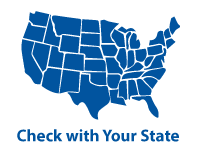
Float plan – Float plans should be a priority. Countless lives have been saved by taking a few minutes to properly fill one out. Basically, a float plan is a detailed itinerary of your planned boating trip including the number and names of passengers, departure and return time and location, and other important information that rescuers would need to find you. For more information on float plans, click here. If you are already familiar with float plans and just want to print one out, click here.
ABYC color codes – Wires have colored insulation for a reason. The color can be used to determine the intended function of the wire. When you are navigating a wiring system with multiple wires, figuring out what goes where can be daunting. By being aware of the ABYC color codes, you can make installation, maintenance, and replacement of wires a much simpler task. For more information about ABYC color codes, click here.
Safety equipment checklist – Having the proper safety equipment on your vessel can make all the difference when it comes to saving a life. The problem is, not everyone knows what equipment they need. The good part? The equipment you need is based on the size of your boat. We have made it easy to determine what you need if you live in Florida. For more information, click here.
Check with your State for additional information – If you live outside of Florida, you need to check with your state’s specific regulations regarding boating safety requirements. If you are new to this process and do not know where to start, the United States Coast Guard gives information about federal laws as well as multiple safety tips. To view their guide on federal laws, click here. It is important to note that it is your responsibility to find your state's specific guidelines to ensure that you are compliant with your local laws.

